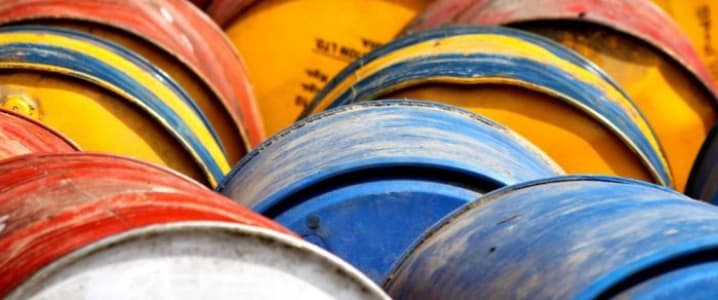The crude complex is feeling charitable today, giving away most of its overnight gains, as last night's bullish API report head-faked the market. As Nonfarm Friday looms next on the radar, hark, here are five things to consider in oil markets today.
1) In the latest feature on NPR's Texas Standard, we discussed how crude waiting offshore in the US Gulf dropped to its lowest since mid-November last week, amid a lull in arrivals from the Middle East. Crude fell 9 million barrels over a two-day period, before rebounding again over the weekend amid a slew of arrivals from Venezuela. Hark, the interview is here, while the drop - and subsequent rebound - can be seen below:
(Click to enlarge)
2) Mexican crude flows to the U.S. have been gradually dropping in recent years, as the Latin American nation looks to diversify away from its main customer (the U.S.), and also amid an ongoing decline in its domestic production.
However, as Canadian heavy crude imports to the U.S. could drop in the coming weeks amid supply disruptions (due to a fire at an Alberta oil sands plant), Mexican barrels could step up to the plate to fill this potential void. The U.S. is still the destination for about a half of Mexican exports:
(Click to enlarge)
Related: OPEC Deal Extension Looks Shaky As Shale Hedges Production
3) Today's inventory report has been fairly underwhelming for the bulls, in light of yesterday's API report which showed three chunky draws to inventories. Today's build to crude stocks and minor draws to the products is causing a tempering of bullish optimism.
Three months into the OPEC production cut & new patterns are starting to emerge. Find out more about how the markets are rebalancing from Clipperdata's Market Snapshot Report.
Refining activity continues to increase, in line with last year, as we exit from refinery maintenance and look ahead to driving season. The aggregated picture, however, disguises a fairly mottled backdrop on a regional basis in the last week.
While Gulf Coast crude inputs dropped by nearly 200,000 bpd on the week prior, the East Coast saw a strong rebound in activity, albeit from an extremely low level. After crude inputs reached their lowest level since February 2015 in recent weeks, PADD1 runs have rebounded by 167,000 bpd, up to 73.6 percent in terms of the utilization rate, from 60.5 percent last week.
(Click to enlarge)
4) With U.S. crude grades heading further afield, the below chart is a useful guide to show when U.S. crude has arrived on Chinese shores - and what grade. As the trend of reverse-lightering and co-loading continues to grow from U.S. shores, an increasing number of U.S. barrels are set to discharge in China in April and May.
(Click to enlarge)
5) Finally, this article provides the stat of the day, as waterborne vessels may have to spend an additional $60 billion each year on fuel come 2020, as new emissions rules kick in. Rules have been approved by the International Maritime Organization (IMO) to cut the amount of sulfur in fuel on merchant ships, from 3.5 percent to 0.5 percent, driving up transportation costs.
Only 2.2 percent of the merchant ship fleet will have scrubbers installed by 2020, meaning the rest will have to buy cleaner, more expensive fuel.
By Matt Smith
More Top Reads From Oilprice.com:
- Is An Iraqi Production Slowdown Inevitable?
- Oil Jumps On Growing Support For OPEC Deal Extension
- When Will Russia Run Out Of Oil?






















